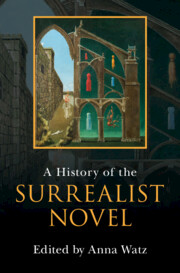Book contents
- A History of the Surrealist Novel
- A History of the Surrealist Novel
- Copyright page
- Dedication
- Contents
- Figures
- Contributors
- Acknowledgements
- Introduction
- I Marvellous Beginnings
- II Transgression and Excess
- III Science, Alchemy, Nature
- Chapter 12 Surrealism and the Science Fiction Novel
- Chapter 13 Pataphysics
- Chapter 14 Alchemical Narratives
- Chapter 15 Animals and Ecology in the Surrealist Novel
- IV Transnational Surrealism
- Index
Chapter 14 - Alchemical Narratives
from III - Science, Alchemy, Nature
Published online by Cambridge University Press: 02 February 2023
- A History of the Surrealist Novel
- A History of the Surrealist Novel
- Copyright page
- Dedication
- Contents
- Figures
- Contributors
- Acknowledgements
- Introduction
- I Marvellous Beginnings
- II Transgression and Excess
- III Science, Alchemy, Nature
- Chapter 12 Surrealism and the Science Fiction Novel
- Chapter 13 Pataphysics
- Chapter 14 Alchemical Narratives
- Chapter 15 Animals and Ecology in the Surrealist Novel
- IV Transnational Surrealism
- Index
Summary
This chapter sheds light on the uses of modern alchemical discourse by three artists and writers who were affiliated with surrealism: British-born artist Leonora Carrington, British artist and occultist Ithell Colquhoun, and Greek poet and critic Nanos Valaoritis. All three writers experimented with the potentialities of alchemical language, writing novels premised upon esotericism and myth in terms of imagery, plot, and sensibility: The Stone Door (1977) and The Hearing Trumpet (1976) by Carrington; Goose of Hermogenes (1961) and I Saw Water (2014) by Colquhoun; From the Bones Rising (1982) and Xerxes’s Treasure (1984) by Valaoritis. Influenced by several strands of the alchemical discourse, Carrington, Colquhoun, and Valaoritis resorted to ideas corroborating the transgression of the dominant Enlightenment concept of the unified rational subject, and utilized them as subversive tropes in their revision of hegemonic body politics. In this revision, identity constitution is conceptualized as a process that is open-ended, non-teleological, and performative. The chapter charts these corporeal cartographies, shedding light on the three writers’ appropriations of alchemy in their writing practices; it shows that the alchemical genre primarily functioned as a platform for the exploration of performative manifestations of identity and contributed to fecund redefinitions of the novel.
Keywords
- Type
- Chapter
- Information
- A History of the Surrealist Novel , pp. 242 - 258Publisher: Cambridge University PressPrint publication year: 2023

